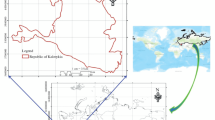Abstract
Groundwater is one of the most important natural resources. Regional groundwater depth is an important parameter for understanding groundwater resources and maintaining sustainable development of water resources and environment. The middle reaches of the Tarim River in Xinjiang are the most primitive and well-preserved place in the world, which provides valuable resources in studying the response mechanism of surface vegetation to the groundwater level. The ecological environment of Tarim River Basin has been deteriorating, and Populuseuphratica forest has died, which is directly related to the decrease of water inflow and groundwater level around the Tarim River. To obtain the spatial distribution of the groundwater level, this study uses the MODIS satellite remote sensing image data and the remote sensing-mathematical-model of a fusion science research methods, based on the field investigation of the groundwater level, soil moisture, and other supporting information on Aeolian desertification area in the middle reaches of Tarim River in Xinjiang. Through the experimental equation of the soil moisture and groundwater level, a simple and effective remote sensing method was proposed. This method is used to evaluate the spatial distribution of groundwater level based on the MODIS image data when there is capillary supply in the soil. This model was field-proven on the desertification area in the middle reaches of Tarim River. The results indicate that the correlation coefficient between the inversion of groundwater depth and the measured groundwater level is 0.89, which are realistic with small errors. So it is feasible to monitor and assess the spatial distribution of groundwater table depth in desertification areas with a large groundwater depth of 6 m or less. This study is helpful to provide critical area for the ecological environment monitoring and restoration, and ultimately serve the sustainable development of water and environment.




Similar content being viewed by others
REFERENCES
Ma, X.H. and Wang, S., Relationship between vegetation degradation and groundwater level and salinity in the Shule River basin, Gansu, Gansu Agric Sci. Technol., 2005, vol. 30, no. 2, pp. 53–54.
Gao, Z.G. and Zhang, L.Q., The identification of spectral characteristics of salt marsh vegetation using indirect ordination, Remote Sens. Land. Resour., 2006, vol. 18, no. 2, pp. 51–56.
Finch, J., Estimating direct groundwater recharge using a simple water balance model—sensitivity to land surface parameters, J. Hydrol., 1998, vol. 211, nos. 1–4, pp. 112–125.
Huo, A.-D., Dang, J., Song, J.X., Chen, X.H., and Mao, H.R., Simulation modeling for water governance in basins based on surface water and groundwater, Agric. Water. Mnage., 2016, vol. 174, pp. 22–29.
Shu, Y.Q., Chen, S.Y., Lei, Y.P., and Zheng, L., The relationship between evapotranspiration in wheat field and the groundwater level in Beijing-Tianjing corridor, Chin. J. Eco-Agric., 2006, vol. 14, no. 3, pp. 71–74.
Tiyip, T. and Ghulam, A., Research on model of groundwater level distribution in the oasis and desert ecotone using remote sensing, Int. J. Remote Sens., 2002, vol. 6, no. 4, pp. 299–306.
Huo, A.D., Yang, L., Peng, J.B., Cheng, Y.X., and Jiang, C., Spatial characteristics of the rainfall induced landslides in the Chinese Loess Plateau, Hum. Ecol. Risk Assess., 2020, vol. 26, no. 9, pp. 2462–2477. https://doi.org/10.1080/10807039.2020.1728517
Huo, A.D., Peng, J.B., Chen, X.H., Deng, L., Wang, G.L., and Cheng, Y.X., Groundwater storage and depletion trends in the loess areas of China, Environ. Earth Sci., 2016, vol. 75, no. 16, p. 1167.
Huo, A.D., Chen, X.H., Li, H.K., Hou, M., and Hou, X.J., Development and testing of a remote sensing-based model for estimating groundwater levels in aeolian desert areas of China, Can. J. Soil Sci., 2017, vol. 91, no. 1, pp. 29–37.
Huo, A.D., Liu, Z.L., Kang, X.W., Hou, M., Xu, D.Y., Jin, J.H., and Da, W., Research on retrieval of land surface temperature in Aeolian desertification areas from MODIS image data, Chin. High Technol. Lett., 2008, vol. 18, no. 5, pp. 511–518.
Komarov, S.A., Mironov, V.L., Romanov, A.N., and Yevtyushkin, A.V., Remote sensing of the water table: Measurement and a data processing algorithm, Mapp. Sci. Remote Sens., 1999, vol. 36, no. 1, pp. 1–10.
Li, J.L., Jiang, P., Liu, P.J., Zhao, D.H., Zhu, M., and Xu, S., The study on dynamic monitoring soil water contents using remote sensing optical method, Acta Ecol. Sin., 2003, vol. 23, no. 8, pp. 1498–1454.
Lunetta, R.S., Knight, J.F., Ediriwickrema, J., Lyon, J.G., and Worthy, L.D., Land-cover change detection using multi-temporal MODIS NDVI data, Remote Sens. Environ., 2006, vol. 105, no. 2, pp. 142–154.
Liu, P.-J., Zhang, L., Kurban, A., Chang, P., Li, L.S., Pularti, and Zhao, B.K., A method for monitoring soil water contents using satellite remote sensing, J. Remote Sens., 1997, vol. 1, no. 2, pp. 135–138.
Huo, A.D., Zhang, J., Cheng, Y.X., Yi, X., Qiao, L., Su, F.M., Du, Y.L., and Mao, H.R., Assessing the effect of scaling methods on retrieval of soil moisture based on MODIS images in arid regions, Toxicol. Environ. Chem., 2016, vol. 98, nos. 3–4, pp. 410–418.
Li, M.M., Wu, B.F., Yan, C.Z., and Zhou, W.F., Estimation of vegetation fraction in the upper basin of Miyun Reservoir by remote sensing, Resour. Sci., 2004, vol. 26, no. 4, pp. 153–159.
Funding
This work was supported by the National Natural Science Foundation of China (grant nos. 41877232, 41672255, and 41790444); National Key R&D Program of China (2018YFE0103800); the Fundamental Research Funds for the Central Universities, CHD (300102299302); Key R & D projects of Shaanxi Province (no. 2020sf-424); Key Laboratory Open Project Fund of State Key Laboratory of Loess and Quaternary Geology, Institute of Earth Environment, CAS (grant no. SKLLQG1909).
Author information
Authors and Affiliations
Corresponding authors
About this article
Cite this article
Chen Siming, Aidi, H. & Wenke, G. Remote Sensing Monitoring Method for Groundwater Level on Aeolian Desertification Area. J. Water Chem. Technol. 42, 522–529 (2020). https://doi.org/10.3103/S1063455X20060090
Received:
Revised:
Accepted:
Published:
Issue Date:
DOI: https://doi.org/10.3103/S1063455X20060090




